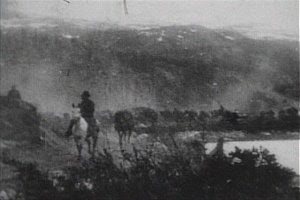
In 1898 Thomas Crahan and Robert K. Bonine, who worked for Thomas Edison came to Skagway and filmed a pack train at the Chilkoot Pass. The film shows eight loaded mules led by a man on horseback. Although it is only one minute long, filmed in summer, it is perhaps the earliest movie shot in this area. Seen above is a still from that film. Crahan went on to Dawson and did some filming there and then returned to Whitehorse to film rapids in 1900. The Klondike Exposition Company was organized by Edison and Thomas Crahan to make a filming expedition to the Yukon in order to produce films suitable for display at the Paris Exposition of 1900.
S.S. Buford
In 1890 the S.S. Mississippi was built in Belfast as an private Atlantic Transport ship. In 1898 she was purchased by the U.S. Army for use in the Spanish American War. Renamed the S.S. Buford (after General John Buford, union cavalry hero of Gettysburg) she saw use as a troop transport ship to the Philippines, as a supply vessel in San Francisco following the great quake in 1906, famine relief missions to China, refugee and troop carrier during the Mexican Revolution and as communication hub for Galveston during the great hurricane there in 1915. In World War One she helped evacuate Americans from Europe and then transported troops. Following the war she brought home 4700 soldiers from Europe.
In 1919 she was dubbed the “Red Ark” and transported 249 “undesirables” back to Russia.
In 1921 she rescued 65 passengers and crew from the burning Tokuyo Maru near Tillamook, Oregon.
In 1923, the Buford was sold to John C. Ogden and Fred Linderman of the San Francisco-based Alaskan Siberian Navigation Company. From July 20 to September 8, 1923 the S.S. Buford sailed up from San Francisco to the Arctic. Here is a list of the ports that this aging vessel visited:
Nome, Juneau, Seward, Wrangell Island, Unalaska, Teller, Ketchikan, Pribiloff Island, Skagway, Duncan’s Bay, Swanson’s Bay, Auk Lake, Cordova, Copper River, Akutan whaling station, Dutch Harbor, Salmon Creek, Taku Glacier, Mendenhall Glacier, Spencer Glacier, Miles Glacier and Muir Glacier.
The Buford was actually commanded by Capt. Louis Lane and went 185 miles north of the Arctic Circle. At that time it was the largest ship to enter the Arctic Ocean. The Buford then went on another trip to the South Seas in early 1924.
It was then that the Buford was chartered for three months by silent movie comedian Buster Keaton for use as the principal set of his film “The Mariner” later renamed “The Navigator.” The Buford had been “discovered” by Keaton’s Technical Director Fred Gabourie while scouting for ships for another, outside project, The Sea Hawk.
Released on October 13, 1924, “The Navigator” proved to be Keaton’s most financially successful film and one of his personal favorites. An aging Captain Johnny “Dynamite” O’Brien (seen above with Keaton) partook in the filming of the movie.
After so many adventures and heroic trips, the S.S. Buford sailed on May 11, 1929 from Los Angeles to Yokaham Japan to be scrapped. If she had been a military person, she would have been decorated, but on her final voyage her only decoration was the American flag which fluttered proudly off her stern.
Wikipedia; Pacific Coastal Liners;
Leonard Scofield Sugden

Doctor Leonard Sugden was born in June of 1873 in Scotland. He first came north on a whaling vessel and practiced in Juneau. In 1897, he headed for the Klondike but had to winter at Marsh Lake, where he built a cabin and worked as a doctor for the NWMP. When the real gold rush began in 1898, he helped pilot boats through Miles Canyon and the White Horse Rapids. Dr. Sugden stayed in the Yukon. He was the inspiration for Robert Service’s poem, the Cremation of Sam McGee when Service heard of the story of Dr. Sugden hauling a corpse to Tagish and contacting the family in Tennessee to get permission to cremate the remains.
Sam Steele mentioned in his memoirs that Dr. Sugden once hauled a woman 100 miles on a sled to get her to medical help and safety.
Dr. Sugden married in 1906 and moved to the Kluane area where he mined, hunted big game and bought a Prizma movie camera. With it he produced, in 1915, a film called The Lure of Alaska which played to rave reviews across America and Europe.
The film includes shots from the Seattle harbor and along the coast of Alaska and features scenes of Juneau, Sitka, Skagway, a midnight baseball game in Dawson City, a caribou herd swimming in the river, and icebergs calving from glaciers. The movie also includes scenes of Sugden piloting a raft through the Whitehorse Rapids.
The New York Times in 1917 wrote:
“Seldom have nature pictures been such a combination of thrills and wild beauty. They are a notable accomplishment of the camera and Dr. Sugden’s nerve.”
Unfortunately, Dr. Sugden’s life of adventure ended suddenly in 1923 when he fell off a barge into the Stewart River near Mayo and drowned. He was 50 years old.
A CKRW Yukon Nugget by Les McLaughlin
